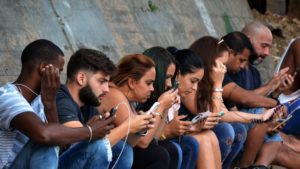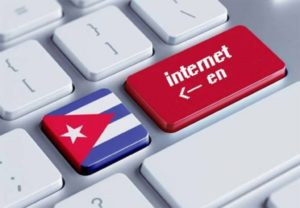 INTERNET EN CUBA: LOS HABANEROS ARRASAN CON LAS TARJETAS PARA CONECTARSE A LA 4G.
INTERNET EN CUBA: LOS HABANEROS ARRASAN CON LAS TARJETAS PARA CONECTARSE A LA 4G.
La ansiedad de los habaneros por conectarse a la red 4G ha arrasado con las reservas de tarjetas USIM, agotadas en buena parte de las oficinas de la Empresa de Telecomunicaciones de Cuba (Etecsa) de la capital, en cuyo litoral comenzó a funcionar esta tecnología el pasado 8 de marzo.
La USIM o Módulo Universal de Identificación del Abonado es un chip para la telefonía móvil que permite la conexión a la red 4G, soporta la realización de videollamadas, tiene capacidad para guardar un mayor número de contactos, además de otorgar seguridad y protección al tráfico de internet. Esta tecnología, a la venta por un importe de 3 CUC, ya se recomendaba para la conexión 3G, pero con la llegada de su hermana mayor se ha hecho imprescindible.
Un recorrido hecho por este diario en al menos una decena de estas oficinas confirmó que incluso en la ubicada en el Aeropuerto Internacional José Martí se han agotado. En atención al cliente de Etecsa aseguran que hay disponibilidad en algunos locales, como los de Carlos III, Águila, Obispo y Monte, pero en todo el municipio de Plaza es imposible encontrar una USIM.
La red 4G se activó en un momento de creciente malestar entre los clientes de la empresa de telecomunicaciones por la mala calidad de la navegación web desde los celulares, que se había agravado en las últimas semanas. El servicio 3G comenzó el pasado 6 de diciembre y, desde entonces han sido frecuentes las quejas por la baja velocidad y calidad de la conexión.
En varias zonas del país los clientes se quejan de que no es posible navegar en la web en las horas picos, se tarda mucho en subir un archivo o que apenas han podido usar el paquete de datos que compraron por el mal funcionamiento de la conexión.
“Lamentablemente no es algo que uno pueda conseguir en el mercado negro, como un teléfono o una funda para el móvil, sino que hay que esperar a que Etecsa tenga las USIM para poder comprarlas”, detalla Lucía, una abogada de 38 años que también espera porque suministre los modernos chip en la oficina cercana a su casa en Nuevo Vedado.
“Cuando no es una cosa es la otra pero con Etecsa es muy raro que algo salga bien de principio a fin”, opina. “Ahora tenemos 4G pero no tenemos tarjeta, vamos a ver qué falta mañana”.
Como 4G se conoce a la cuarta generación de tecnologías de telefonía móvil, posterior a las 2G y 3G, que ofrece velocidades máximas de transmisión de datos que van de entre 100 Mbit/s (12,5 MB/s) en movimiento hasta un 1 Gbit/s (125 MB/s) en reposo.
La red 4G está en pruebas hasta la fecha y a ella pueden conectarse los usuarios que generen tráfico superior a 1,5 GB con las mismas tarifas o paquetes vigentes para los datos móviles a través de la 3G. Etecsa anunció este viernes la bajada de la cantidad exigida para ser usuario de la red, que inicialmente era de 2,5 GB.
El servicio cuesta 10 centavos de CUC por megabit, aunque la mayoría de los usuarios se acoge a la opción de comprar uno de los cuatro paquetes de datos, que van desde 600 megabits por 7 CUC a 4 gigabits por 30 CUC, este último es el equivalente al salario mensual de un profesional.
Al concluir el mes de enero, Etecsa tenía 5,4 millones de líneas activas y el crecimiento promedio mensual era de 50.000 nuevas líneas, según datos oficiales. El 40% de los usuarios de la telefonía móvil “genera tráfico de datos de algún tipo”, ya sea por el uso del correo Nauta, los MMS o la navegación web.
 INTERNET IN CUBA: 4G SIM CARDS FLY OFF THE SHELVES.
INTERNET IN CUBA: 4G SIM CARDS FLY OFF THE SHELVES.
The anxiety of the inhabitants of Havana to connect to the 4G network has devastated the reserves of USIM cards, sold out in a good part of the offices of the Telecommunications Company of Cuba (Etecsa) of the capital, in whose coast this technology began to operate. last March 8.
The USIM or Universal Subscriber Identification Module is a chip for mobile telephony that allows connection to the 4G network, supports video calls, has the capacity to store a greater number of contacts, in addition to granting security and protection to traffic. Internet. This technology, for sale for an amount of 3 CUC, was already recommended for the 3G connection, but with the arrival of its older sister it has become essential.
A tour made by this newspaper in at least a dozen of these offices confirmed that even in the one located at the José Martí International Airport have been exhausted. Inattention to the client of Etecsa they assure that there is availability in some places, like those of Carlos III, Águila, Obispo, and Monte, but in all the municipality of Plaza it is impossible to find a USIM.
The 4G network was activated at a time of growing discomfort among the customers of the telecommunications company due to the poor quality of web browsing from cell phones, which had worsened in recent weeks. The 3G service began on December 6 and, since then, complaints about the low speed and quality of the connection have been frequent.
In several areas of the country, customers complain that it is not possible to surf the web during peak hours, it takes a long time to upload a file or that they have barely been able to use the data package they purchased due to the malfunction of the connection.
“Unfortunately it’s not something that you can get on the black market, like a phone or a mobile phone case, but you have to wait for Etecsa to have the USIM to buy them,” says Lucia, a 38-year-old lawyer who also he waits because he supplies the modern chip in the office near his house in Nuevo Vedado.
“When it’s not one thing it’s the other but with Etecsa it’s very rare that something goes well from start to finish,” he says. “Now we have 4G but we do not have a card, let’s see what’s missing tomorrow.”
As 4G is known the fourth generation of mobile telephony technologies, after 2G and 3G, which offers maximum data transmission speeds ranging from 100 Mbit / s (12.5 MB / s) in a movement to 1 Gbit / s (125 MB / s) at rest.
The 4G network is in testing to date and it can connect users who generate traffic exceeding 1.5 GB with the same rates or packages valid for mobile data through 3G. Etecsa announced on Friday the drop in the amount required to be a user of the network, which initially was 2.5 GB.
The service costs 10 cents of CUC per megabit, although the majority of users accept the option of buying one of the four data packages, which range from 600 megabits per 7 CUC to 4 gigabits per 30 CUC, the latter being the equivalent to the monthly salary of a professional.
At the end of January, Etecsa had 5.4 million active lines and the average monthly growth was 50,000 new lines, according to official data. 40% of mobile phone users “generate data traffic of some kind”, whether through the use of Nauta mail, MMS or web browsing.
Agencies/ 14ymedio/ Marcelo Hernandez, La Habana/ Extractos/ Internet Photos/ Arnoldo Varona/ www.TheCubanHistory.com
THE CUBAN HISORY, HOLLYWOOD.
OVER 7,000 ARTICLES ABOUT CUBA. (SEARCH < www.TheCubanHistory.com



 < INTERNET IN CUBA: 4G Sim Cards Fly Off the Shelves in Cuba. Photos.
< INTERNET IN CUBA: 4G Sim Cards Fly Off the Shelves in Cuba. Photos.





